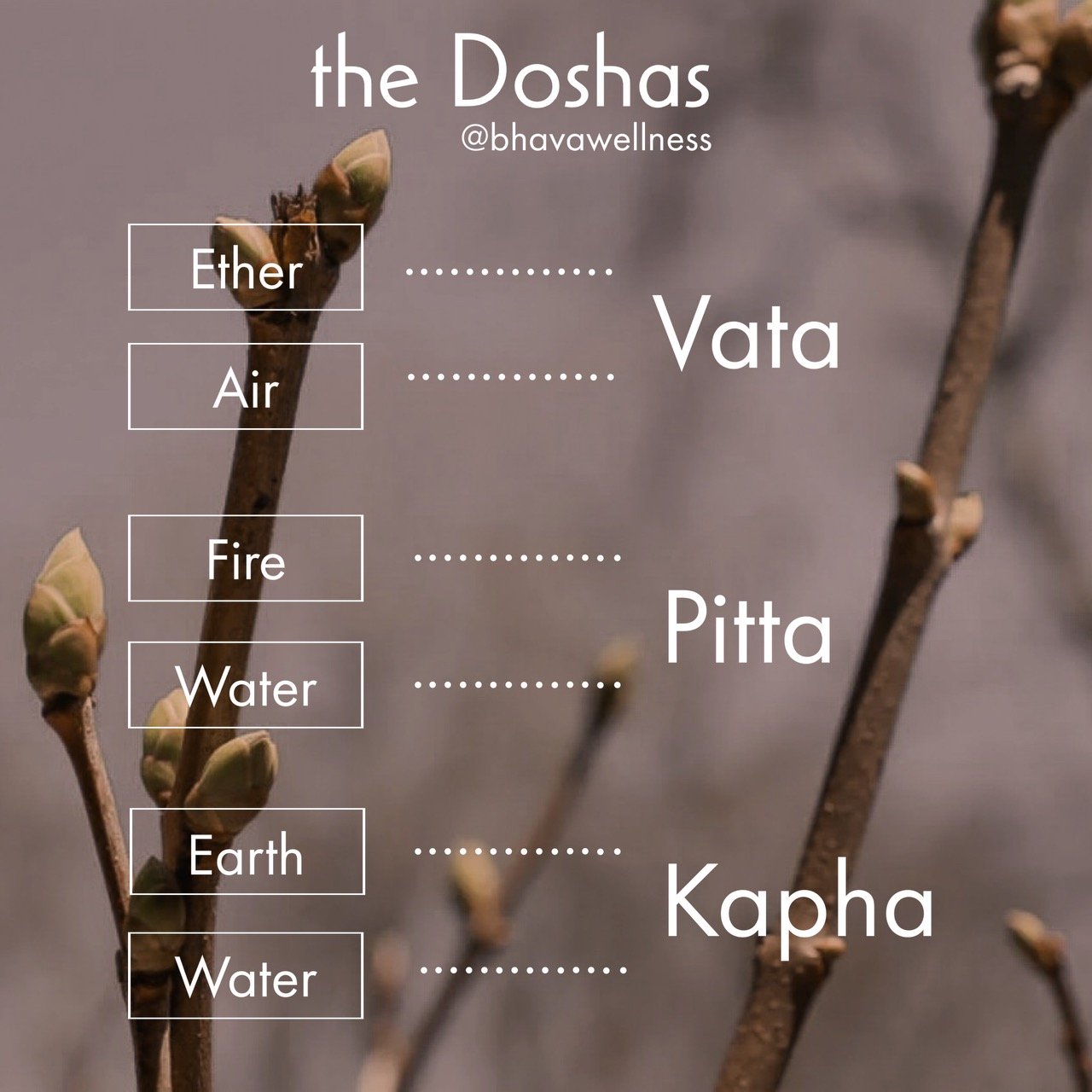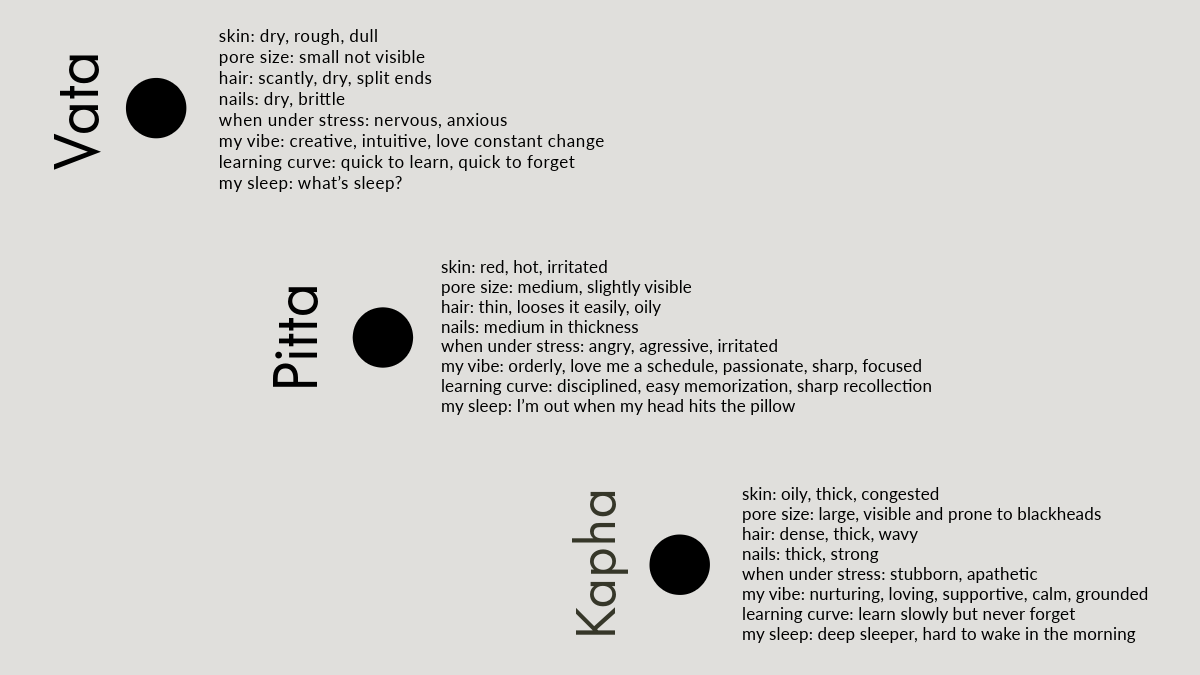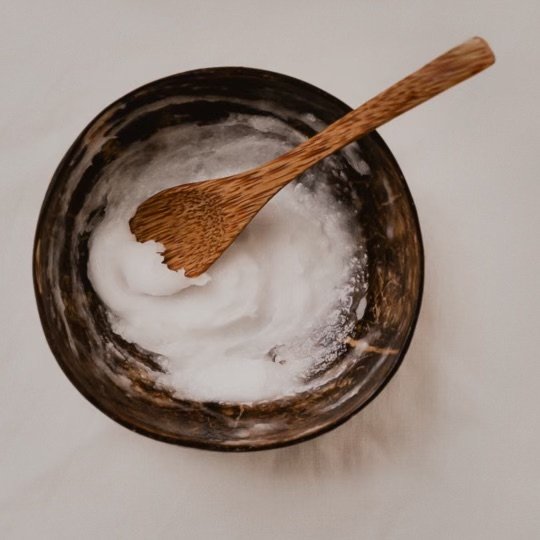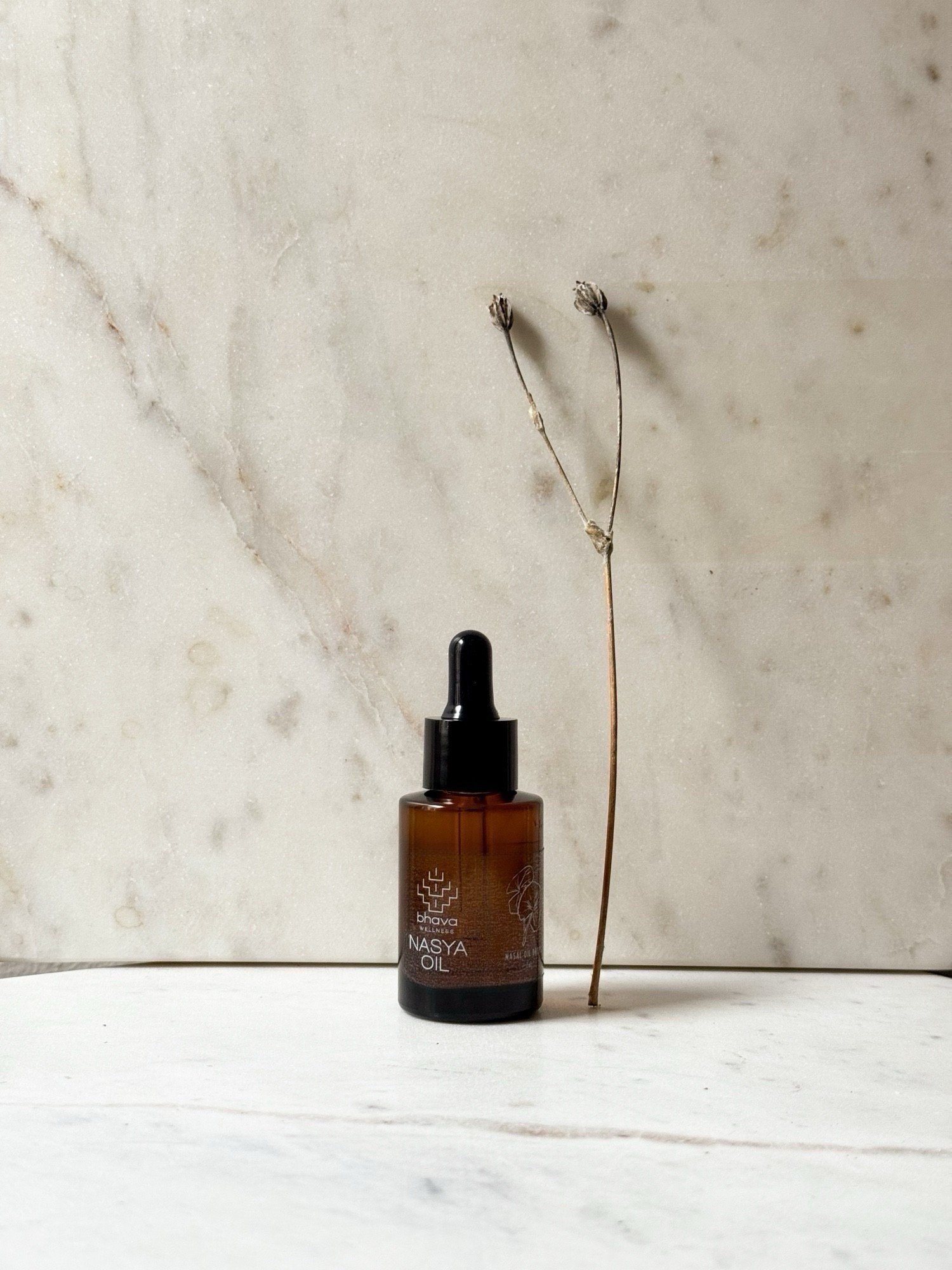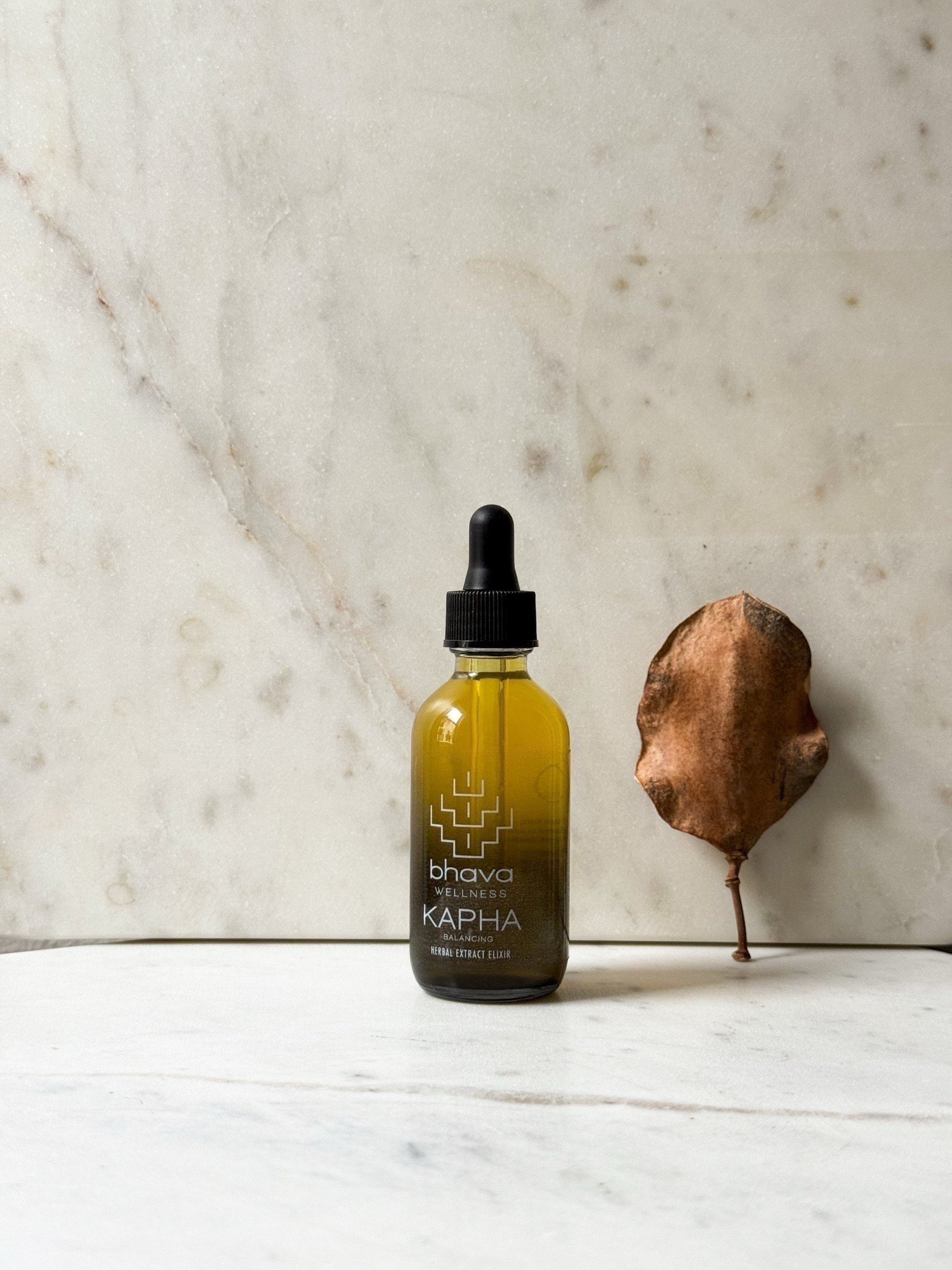Welcome
glad you found us,
Below you will find everything you need to begin your Ayurvedic Lifestyle Journey
What is Ayurveda?
What are the Doshas?
What is a daily Dinacharya?
What products are for me?
living an ayurvedic lifestyle
Ayurveda teaches us respect for Nature, appreciation of life and it gives us the means to empower ourselves. It is holistic medicine and daily lifestyle practices at its BEST.
Ayurveda is ritual medicine.
Prayer, invocation, sound, smell, herbs, transformation and intention to to name a few. These are all classical philosophies that grant us the solid framework and rooted principles to help us begin to understand our realities and make the necessary changes for balance and growth.
Ayurveda is a life science that helps us to bridge the gap between our individual experience and our spiritual/ritualistic experience, bringing us closer to living in harmony on our journey for truth and peace of mind/heart/body.
Dive in to the experience.
learn more by clicking the link below
an intro to the doshas
What we love about Ayurveda (The sister science to Yoga) is that it really helps us to understand who we are. And when we begin to know who we are, we can make small but powerful changes to how we live which, when they take root, can blossom into great health, vitality, clarity, and personal evolution.
how to find the right path?
Well, the first step is in understanding your dosha.
The three main doshas (constitutions) are Vata, Pitta and Kapha. We are all a unique combination of these doshas – these doshas are all based around Pancha Maha Bhutus (the 5 elements). Less often is our natural constitution singular (just vata) or tridoshic (vata/pitta/kapha).
Ideally, our aim in Ayurveda is to bring our current state closer to our natural state. So, once we find our natural constitution, we begin to understand where our current state is out alignment with our healthy natural state. This is when we can practice even a few small changes and these can have dramatic impact and life long effect.
Dinacharya:
A guide to your daily ayurvedic routine
Dinacharya is an important principle and practice in Ayurveda.
It refers to a daily routine that's meant to maintain and promote physical + mental and spiritual health. According to Ayurveda, establishing a healthy and consistent dinacharya allows the body to be in tune with the cycles of nature, affording and promoting us optimal wellness while boosting our immunity.
These daily practices help to create balance during the changes in doshas (the ever changing combination of elements...think seasons as an example), which occur naturally throughout the cycles of the day, week and month. The amazing activities included in Dinacharya may look like... cleansing, clearing, and bringing balance using specific tools such as Neti Pot, Nasya, Tongue Scraping, Oil Pulling, Abhyanga Self Massage, Exercise, Study, Breathwork, Meditation and Yoga.
an Introduction to ayurveda
What is Ayurveda?
What we love about Ayurveda (The sister science to Yoga) or further broken down into it’s beautiful Sanskrit Ayus - translated to Life and Veda - translated to Knowledge is a lifestyle Science really helps us to understand who we are.
When we begin to realize who we are, we gain tools to make powerful changes to how we live which, when they take root, can blossom into great health, vitality, clarity, and personal evolution.
Ayurveda informs us that there is not one perfect diet for everyone, no perfect exercise program, and certainly not one lifestyle plan that suits all. In this ancient science we learn to understand our own natural constitution (prakruti), and our current state (vikruti) and how we can bring our current state closer to our natural state for great health. Not everyone is designed to eat raw. Not everyone is their healthiest with the most vigorous yoga or fitness program. Not everyone needs 8 hours of sleep each night. Some of us would benefit from these practices, but not all of us.
Have you ever tried challenging yourself with a healthier lifestyle plan that is designed specifically for you? What to say about discovering and then practicing rituals + herbal medicine + food choices + environments specific to you and YOUR individual needs. Sounds heavenly right?
how to find the right path?
Well, the first step is in understanding your dosha.
The three main doshas (constitutions) are Vata, Pitta and Kapha.
We are all a unique combination of these doshas – all based around Pancha Maha Bhutus (the 5 elements).
The elements are:
Ether, Air, Fire Water, and Earth.
VATA DOSHA — is a combination of the elements of Air and Ether
PITTA DOSHA — is a combination of the elements of Fire and Water
KAPHA DOSHA — is a combination of the elements of Earth and Water
find your Dosha chart
Ideally, our aim in Ayurveda is to bring our current state closer to our natural state so that we may live our purpose.
once we find our natural constitution, we begin to understand where our current state is out alignment with our healthy natural state.
Ayurveda provides us with a multitude of daily practices (Dinacharya) food guidelines, herbal remedies, meditations, breathwork practices, mantra, and movement therapies to help us create a harmonious balance so that we may heal ourselves physically, mentally, and Spiritually. When we prioritize practicing even a few small changes for our growth & wellbeing,
these can have a dramatic impact and life long effects.
We look forward to hearing how you flow with Ayurveda.
We hope that you fall in love with this helpful healing path as much as we have!
An intro to dinacharya
daily practices
what is dinacharya?
In Sanskrit, din means ‘day’ and charya means ‘behaviour’ or ‘discipline’ so Dinacharya is the healing tools that we practice that make up our Ayurvedic daily routine. Through the dedication of this daily routine, we can live life in a more connected and more balanced state so that we can maximize our health and wellbeing. These daily tools help keep the body and mind in tip top shape so that may live to our upmost potential.
Dinacharya offers us an in depth but doable schedule, outlining what time is the best to wake up and all of the wonderful to-do’s that follow that allow us to great each day with our most balanced self.
Examples include:
morning routines like:
tongue scraping + oil pulling + Neti Pot, Nasya Oil, Abhyanga Self Massage, showering + bathing rituals
followed by:
Movement practices, mantra, meditation, Pranayam (breathwork), when to eat, sleep, etc.
As with most Ayurvedic practices, your unique Dinacharya will vary according to your dosha constitution but we have outlined a Tridoshic (good for all 3 Doshas) Dinacharya that is practiced by most people. As you learn more about your Dosha, you will learn where you might want to make subtle changes.
Dinacharya -
daily morning routine
These practices are best to do between the hours of 5-9am since we are practicing mirroring the awakening of the Sun in our lives. These early morning times are when we are most open and naturally welcoming for both self care and spiritual connection.
First practice is a short but potent gratitude practice, this happen when we first open our eyes before we even place out feet on the ground. Appreciation for the day ahead, the fact that the Sun rose for us and that we have clean air to breathe are all great things to be grateful for. This practice is yours so get creative with it.
Good Morning!
Head to the ole loo and do your thing. Wash your hands and then splash cool water over your face and eyes, this helps to awaken your senses for the practices ahead. Since you are most likely looking in the mirror, go ahead and give yourself a little self love. I’ll wait…<3
Tongue Scraping
First thing before you brush + floss is glide over your tongue with your copper Tongue Scrapers anywhere from 5-10 light passes until your tongue appears clear. It’s quite shocking how handy this little tool is.
Quick question just to make sure you understand how important this practice really is…would you eat your own poop? Our guess is probably not ha!
Well you know that white/yellow/grey (depending on your Doshic imbalance that shows up on your tongue in the morning after a good night’s rest? Don’t swallow that, it’s toxic waste (bad bacteria) chillin on your tongue left over from your undigested food.
When we sleep, our digestive system remains awake. If we don’t remove + scrape these toxins they get reabsorbed by the body and can cause a rollercoaster of harmful diseases + digestion issues + emotional imbalance and definitely a compromised immune system. This simple practice can help remove all those unwants. All you need to do is get your hands on a tongue scraper and use it everyday!
(We have wonderful copper ones in the shop you can purchase here)
First thing in the AM scrape your tongue from back to front and see the funk that comes off- wash it away and repeat a few more times.
Rinse you’re scraper and head to the kitchen for a warm glass of lemon water to start your day.
Oil Pulling
What is Oil Pulling?
and why is IT most beneficial for healthy oral hygiene?
What is Oil Pulling?
Maybe you’ve heard of an Ayurvedic oil pulling treatment, but you’re not sure what it means or how oil pulling works.
Or maybe you’re wondering whether there is any actual benefit to putting oil in your mouth?
Oil pulling grants us such health benefits as improving oral flora, preventing tooth decay, alleviating bad breath, and strengthening the tissue of teeth and gums. In addition to brushing your teeth, flossing, and scraping your tongue, oil pulling with sesame oil, coconut oil, or one of our specially formulated Daily Swish oils is a safe and effective bonus to a healthy oral hygiene routine. Both Western medicine and Ayurveda use the tongue as an important diagnostic tool, (a roadmap) indicating the fact that a healthy mouth and a healthy tongue is interrelated to the health of the entire body, supporting our oral hygiene is a benefit for our general health.
In fact, our mouths are host to over 600 different species of bacteria which populate the teeth, tongue, soft tissue of the cheeks and palates, and our tonsils. The oral cavity further adjoins the esophagus, nasal passages, sinuses, and the intricate ear cavities. So you can see why bad bacteria in the mouth is a big deal!
INSTRUCTIONS
* Start by putting 1 tablespoon of oil in your mouth.
* Swish and pull the oil in the mouth, moving it around both sides, and in front of, behind, and through the teeth.
* Continue the process for anywhere from 5-20 minutes, until the oil has become thin and whitish in color.
(You will want to work up to this time frame, but to start, try to swish for at least 5 minutes for best results.)
* Spit out the oil in the trash or toilet, rather than down the drain, to avoid clogging the drain. Do not swallow the oil.
* Rinse the mouth with warm water.
Warm water and lemon
15 exciting examples of
why drinking warm lemon water in the morning on an empty stomach
is one of the simple things you can add to your daily routine which has a large impact on your overall health.
This gorgeous fruit is a great source of vitamin C, vitamin A, beta-carotene, folate, calcium and potassium - just to name a few of incredible vitamins it contains. When you drink lemon water first thing in the morning, you’re bring your body back into alkaline and feeding your skin an important dose of vitamin folate. Found in all citrus fruits and juices, this vitamin helps to eliminate toxins from your body, helping to prevent acne and can even give your skin a natural glow.
Here are a few more amazing reasons we suggest adding morning lemon water to your daily routine.
* As a rich source of vitamin C, lemon juice protects the body from Immune system deficiencies.
Drinking lemon juice with warm water every morning helps in maintaining the pH balance of the body.
With its powerful antibacterial properties, lemon juice helps fight infections
Acts as a detoxifying agent.
Helps with maintaining digestive health, preparing the digestive tract for the day
Along with vitamin C, lemons are also a rich source of potassium, calcium, phosphorus, magnesium etc.
Helps fight the common cold
Lemon juice with warm water helps us balance excess weight as it promotes digestion and increases the metabolic rate
Lemon juice is also very effective at cleansing the liver as it promotes the liver to flush out toxins
Lemon’s anti-inflammatory properties help in fighting respiratory tract infections, sore throat and inflammation of tonsils
Lemon juice with warm water helps keep the body hydrated as it provides much loved electrolytes to the body
Drinking lemon juice with warm water also helps reduce joint and muscle pain
Lemon juice with warm water is good for your dental health as it helps with toothache and prevents gingivitis
Lemon juice with warm water helps with digestion and hence, helps regulate natural bowel movement
Elimination
We aren’t shy…and luckily Ayurveda has a lot to say about how common imbalances in our digestive system are and the tools we can practice to correct them. It’s definitely time to cast aside all embarrassment so that we can tend to and support our bodies in this incredibly important daily must do-do. Get it?
This resource explores Ayurveda’s perspective on this topic in some depth
The honest truth is that our bathroom habits
*especially our stool tells us a great deal about what we need in order to return to balance.
Ayurveda helps up to realize that digestive tract is usually the very place that imbalances begin in the body
and because of this, our stools show us early warning signs that something is out of balance.
Most of the time the imbalance is fairly minor at first, so it’s important that we stay on top of it.
When these imbalances are not addressed, they tend to make home in the digestive tract
as a more stubborn and serious condition, or worse off, they manifest in other tissues and cause larger more long term disturbances.
When we tend to the early indications, we take a proactive stance, we have the ability to quickly course-correct and heal ourselves.
It’s pretty radical what we can understand about ourselves by paying attention to our bowel habits and checking out the ole poo ha!
What Defines Healthy Elimination?
healthy elimination occurs one to two times daily.
Balanced stools are typically:
well-formed, consistency of a ripe banana.
Are a light brownish to yellow color.
Tend to float
Are a little oily
Are not sticky. doesn’t stick to the toilet.
Is only mild in odor.
Common Imbalances in the Elimination Channel
There are so many wonderful tools we can use to achieve healthy elimination (see our general guideline below for some examples)
Identifying whether Vata, Pitta, Kapha, or a combination of the Doshas are present in the imbalance shows us how and where to apply focused and specific therapeutic healing strategies.
Hydrate
Hydrating properly is crucial to both healthy digestion and health elimination. You can’t have either without it. Dehydration causes dark, colorful, stinky or even a lack of urine which can cause all kinds of digestion problems.
One of our favorite hydrating practices is drinking a cup or two of warm water and lemon upon waking, and a large glass (about two cups) of warm or room temperature water 20–30 minutes before each of your meals.
These healthy practices help hydrate the tissues and awaken your overall digestive capacity, automatically improving digestion.
Ayurveda recommends avoiding iced beverages (including iced water) what? I know…trust us on this one…it’s a game changer.
Ayurveda also recommends no more than a few sips of water (or other beverages) with meals. Fluid when taken with food puts out your digestive fire and effects the overall digestive process.
Not having drinks that are loaded with sugar and caffeine are beneficial to healthy digestion.
Diet
Food as Medicine has a profound effect on elimination. A healthy Ayurvedic diet highlights nutritious, seasonally appropriatel, whole foods and limits processed foods and refined sugars. From an Ayurvedic outlook, it’s what we eat, how we eat, where we eat, and how much we eat.
Eating your food is a spiritual practice,
we take into consideration:
where this wonderful food came from?
how it was grown?
while we are cooking it…we are in deep gratitude and offering…and then we take it in we allow ourselves to take a few minutes to sit with a gratitude prayer.
This makes what we eat so much more medicinal, so much more nurturing and so much more satisfying to our body + mind + spirit.
quantity
Most of us (especially in America) are accustomed to eating large meals.
Ayurveda recommends much smaller meals: or the amount of food that we could hold in our two cupped hands would be the size of one meal.
This is the size of our stomach and when we eat any more than that we stretch out stomach which in turn makes us feel the need to eat more food than we actually need.
Allowing time in between each meal with little snacking works nicely because the metabolic function works best when it is allowed to completely digest one meal before it starts in on another.
It is good to allow at least 3–4 hours between meals. (this timeframe can change depending on the meal and the individual but the feeling of natural hunger is a great indicator that the digestive system is ready for action!
Bhava Wellness digestive aids
Daily Digestive Tincture
Our Tridoshic Daily Digestive supports the GI tract and promotes healthy optimization of the liver, freeing the gut of blockage, congestion, stagnation, gas and undigested food. supports nutrient absorption, providing us with vibrant health.
all organic ingredients:
cumin, coriander, fennel, lemon balm, ginger root, licorice root, sweet orange peel in distilled spirits.
easy to take - one dropper full under the tongue or in your favorite hydrating beverage before meals.
Fire Cider for Digestion
Whatever it is, the way you tell your story online can make all the difference.
Our Fire Cider is a warming supportive tonic to boost the immune system,
it assists in respiratory health, and stimulates digestion.
Fire Cider is a traditional remedy made from apple cider vinegar infused with supportive herbs for the immune system & digestive system. This spicy and sweet daily dose of wellness works to reduce inflammation in the body, wards off colds & flus, and supports respiratory health.
enjoy this earthy folk remedy daily!
Neti Pot
WHY USE A NETI POT?
Neti pots can relieve pain, pressure and congestion by liquefying the excess mucus in your nasal passages and flushing it out.
This keeps the cilia (basically, tiny hairs) in your nasal passages moving so they block out bacteria, allergens and other irritants.
Congested or dry sinuses can be a breeding ground for infection.
Using a neti pot can easily fit into your daily cleansing routine. All it takes is a few short minutes – just like brushing your teeth. Gravity gently does the work of rinsing the sinuses- that’s the beauty of using a Neti Pot.
HOW OFTEN SHOULD I USE MY NETI POT?
This is our most frequently asked question.
The answer is simple – listen to your body – however, it requires you to experiment a bit.
Below are a few suggestions how to do this:
For maintenance:
Some people benefit from rinsing daily as it opens up their sinus passages. Others may find it too drying. See what works best for you and contact us if you need help.
For colds:
Rinsing 2 to 4 times a day can be helpful to flush out infection and liquefy mucus. Do this for the duration of your cold.
For allergies:
Rinsing at least once a day will help flush out pollen and allergens.
For chronic sinus problems:
Listen closely to your body. Everyone is different. Some people benefit from rinsing daily, while others do it once a week.
WHAT TIME OF DAY IS BEST?
When you first wake up and at least an hour before bed (this allows your sinuses to drain before you sleep). If you have a cold, you may want to rinse during the day. If you have allergies, rinsing at the end of the day to clear the sinuses from pollen may be your best bet.
SHOULD I USE FILTERED WATER?
No. Water filters, such as Brita, are not able to remove bacteria and other undesirables.
WHAT IF I FEEL STINGING?
If you experience a bit of stinging,
adjust the level of salt.
People tend to use too little salt.
Also adjust the water temperature –
it may be too hot or too cool.
Neti Pot + salt offerings
Nasya
a daily practice of using herbal oil to:
lubricate, protect, moisturize and clear our nasal passageways so that we can relieve symptoms of anxiety, depression, adhd, fogginess of the mind, allergies and promote good health, clarity of mind and a clear channel to take in fresh prana.
HOW TO USE:
daily use:
place 1-2 drops on clean fingertip & apply into nostril.
or with your head tilted back, place place 1-2 drops inside your nasal passageway and gently breath in.
repeat on opposite side.
weekly use:
with head tilted back, apply 3-5 drops of oil into nostril. inhale deeply. repeat on the opposite side.
please note:
if you are using a neti pot, always follow up with nasya oil.
wait until your nasal passageways are dry after using your neti pot before using nasya.
this usually takes just a few minutes.
BONUS TIPS:
place an extra drop on both of your pointer fingers and massage the inside of your nasal passageways.
This daily practice is a game changer and does wonders for our overall health + mental health and vitality.
Nasya is Ayurveda’s unique practice for maintaining the vitality of this passageway and supporting the prana channel with cleansing and nourishing herbs.
Paying close attention to and caring for the respiratory pathways
and addressing respiratory imbalances is an incredibly worthwhile endeavor.
These daily practices are known to be completely transformative.
In fact, the nostrils are there to balance our respiratory pathways and they are also intimately linked to the subtle energetic pathways of the lunar and solar channels known as ida nadi (lunar) and pingala nadi (solar).
This connection illustrates the importance of protecting the respiratory pathways via the nostrils.
The subtle effects of this practice are effective throughout our entire energy body,
whether we are introducing a breathing exercise or simply applying an herbal oil to the nostrils.
Dry Brushing
Dry Brushing
Dry brushing helps to stimulate kapha (the sluggish, heavier and at times over abundant elements of earth and water) in the body and encourage movement and even drainage of excess mucus.
GARSHANA
dry brushing
this particular dinacharya practice promotes lymphatic cleansing and is a powerful way to encourage the removal of ama (the unwanted buildup up toxins) from the body.
using a natural bristle body brush, this wonderful practice is recommended for everyone and all doshas but especially for people who have signs of ama, which may include:
* fatigue
* stress
* sluggishness
* feeling physical or mental dullness
* depression
* constipation
* a taxed immune system.
Most people would benefit from this practice 1-3 times weekly.
Abhyanga
WHAT IS ABHYANGA SELF MASSAGE?
AND WHY IS IT IMPORTANT?
abhyanga is the ayurvedic term for lovingly oiling the body.
practicing abhyanga regularly provides a profound feeling of stability, strength and well-being.
think of making moisturizing yourself a ceremonial practices with a laundry list of health benefits!
the sanskrit word literally translates “to love oneself”
through this daily practice, we work to restore balance to the three doshas, we increase and improve our circulation, the practice improves skin tone, tonifies both our skin and muscles, increases stamina, calms the nerves, and counteracts the effects of aging all while cultivating self-appreciation.
The Wonderful benefits of abhyanga
are you ready?!?!
-Nourishes, provides tonification, protects & hydrates the skin
- encourages healing of the dhatus (our many layers of tissue) of the body
- Rejuvinates and protects the nervous systems, grounding us in our body & mind
- Encourages healthy more restful sleep
- Works to detox the lymphatic system and promotes healthy circulation
- Promotes vitality and decreases the effects of aging to quickly
- Stimulates the internal organs, encouraging correct flow and optimal health
- Assists apana vayu, or the downward moving energy (apana vayu) which works wonders for healthy elimination
how to perform abhyanga
regular massage & loving touch detoxifies the body’s tissues, increases circulation, nourishes the skin, calms the mind, & enhances immune function.
• begin by placing your custom abhyanga oil in hot water until it becomes a pleasant temperature.
• bring a pot of water to a warm temperature (not boiling) remove it from the heat & place your oil inside the pot or bowl.
• lovingly massage oil into body for 10-15 minutes, beginning at extremities & working towards center of body.
• vigorously massage feet & hands using back-and-forth motions with the open part of your hand.
• massage arms & legs with circular strokes on joints, & long, back-and-forth strokes on limbs.
• massage abdomen using clockwise motion, following the direction of large intestine & colon.
• massage chest with small, upward, circular motions, starting on bottom of breastbone making way up to collarbone
• massage back as well as you can. you can use a downward stroke on lower back to help increase downward flow of energy.
• once you have massaged your entire body, let oil penetrate into skin for as long as you can & then enjoy a warm bath or shower.
• you can also use this oil as a daily moisturizer, using it after the bath + shower or anytime that you skin needs extra moisture
WHICH OIL IS BEST FOR YOU?
you can either choose by connecting to the key words that are listed on our bottles..for example
VATA “NOURISHING + GROUNDING”
PITTA “CALMING + COOLING”
KAPHA “UPLIFTING + REVITALIZING”
or you can use our handy dandy chart listed above in finding your dosha (constitution) and go from there
you can also use our dosha specific pages by clicking the links above to read more about each of the 3 doshas
if you still have questions, please always feel free to reach out
and we will ask you a set of questions that will help reveal which body oil is best for your practice.
you can email us here
Abhyanga herbal body oils
Vata body oil
grounding + nourishing
A grounding herbal oil crafted to soothe and nourish dry skin and promote healthy circulation.
Pitta body oil
calming + cooling
A calming herbal oil crafted to cool, soothe & hydrate your skin.
Kapha body oil
uplifting + revitalizing
A revitalizing herbal oil crafted to inspire, replenish and uplift your body and mind.
Pranayama breathwork
Balancing breathing exercises or Pranayama in Sanskrit translates to “discipline the breath”.
Prana is the breath also known as our ‘life force energy’ and yama translates to “control or discipline”. The movement of the breath directly effects our life energy - our thoughts - our actions - our feelings. Think of when we are stressed or anxious - the first thing to go is the quality of our breath.
We need fresh prana in order to be balanced and accomplish our goals. We we practice Breathwork and learn to control it, we learn to direct it where it needs to go. When Pranayama is practiced daily, the mind and body awakens, balance is maintained, and energy is focused in a harmonizing way.
There are many beneficial pranayama practices and each of them are designed to bring balance there unqiue way.
it is best to learn about the effects they have on each dosha so that you choose which is best for you.
below is an example suitable for each dosha
Pranayama for the doshas
Nadi Shodhana
opposite nostril breathwork
Vata is made up of the elements of air and ether. The qualities of Vata Dosha manifest as dryness, coldness, roughness, light, and mobility.
This form of pranayama is called Nadi Shodhana. It involves rhythmic, grounding, and calming inhalation and exhalation alternating through each nostril.
This practice works wonders for releasing physical and emotional stress, stiffness in the muscles, and balances both our solar and lunar energies. For mental clarity and reducing anxiety, Nadi Shodhana works to still the wavering mind.
How to practice Nadi Shodhana
Find a comfortable seat finding length in your spine to the top of your head.
Make sure you feel warm.
Close your eyes.
Close the right nostril by applying gentle pressure with the right thumb, gently resting your pointer and middle finger on your third eye area.
Inhale gently through the left nostril for a count of 4
Then, close the left nostril using the ring finger of the same hand.
Lift the thumb from the right nostril and exhale through the right nostril for a count of 4
Inhale through the right nostril slowly and gently and exhale through the left nostril, continuing at a comfortable and controlled rhythm. The breathing should be soft, smooth, relaxing, and comforting.
Practice this for 5 to 10 minutes every day and you will find yourself feeling more grounded, free of mind clutter, and overall rejuvenated.
Sitali
cooling and calming breathwork
Pitta is made up of the elements of water and fire. The qualities of Pitta Dosha manifest as warmth even over heated, oily, pungent, sharpness, and light.
This form of pranayama is called Sitali Breath. It calms the body and the mind specific by producing a cooling effect.
Practicing Sitali Breath if you are of dominant pitta dosha or even through the hot summer (Pitta Season) months brings almost instant relief. You can also call upon this practice when you are feeling irritated, frustrated, and angry.
It can help calm and balance those who suffer from Pitta digestive disturbances due to the increased secretion of acid and irritation in the stomach.
How to practice Sitali
Find a comfortable seat finding length in your spine to the top of your head.
Gently place your hands on your lap with the palms facing up (this opens up the channels to recieve) and close your eyes.
Curl your tongue and take in a deep and refreshing breath.
Next close the lips and gently touch the tip of the tongue to the roof of the mouth.
Exhale slowly through the nose.
Practice this on repeat.
Find a relaxing rhythm and continue this practice for 3 to 5 minutes or until you feel refreshed, cooled, and balanced both mentally and physically.
This Breathwork practice helps to restore coolness and brings spaciousness in the mind and body.
Bhastrika
Warming + Energizing breathwork
Kapha is made of the elements of earth and water. The qualities of Kapha Dosha include heaviness, stickiness, stagnation, oily, and coolness.
This form of pranayama is called Bhastrika. It stimulates warmth, revitalization, and balances excess Kapha. It also works to both increase and regulate the flow of prana through the nadis (energy channels) of your body.
This practice helpsr those who suffer from respiratory distress that causes excess mucus secretions and congestion in the nose, sinus cavities, and lungs. It works to enliven dullness and stagnation in the mind and body.
Bhastrika should be practiced on an empty stomach since it works to break up the excess mucus in the nose and lungs, allowing these channels to loosen up and regulate a more balanced flow. Have a tissue handy while practicing.
How to practice Bhastrika
Find a comfortable seat finding length in your spine to the top of your head.
Take a few deep inhales and exhales to begin to relax, softening your facial muscles and jaw.
Inhale deeply through the nose for a count of 6, while flaring open the ribs.
Exhale fully, allowing the lungs to deflate as much as possible but without causing discomfort.
Continue this same count, emphasizing equally on the flaring inhalations as well as the deflating exhalations. Be sure to keep your spine straight to help move out the excess Kapha (or mucus/stagnation)..
bonus tip: lift both arms into the air and practice holding them up while you are taking the inhalations.
Practice anywhere from 3 to 10 minutes.
Asana (movement practice)
Yoga utilizes Asana for purpose of keeping the body strong, tone and supple. When we take care of our body in such a way, we are able to manage and invite high frequency Prana. Yoga Asana is a movement practice that encourages strength, flexibly, muscle tone and cardiovascular health.
Ayurveda approches Asana specific to the individual. These practices are categorized for their effectiveness on each of the doshas. Ayurveda takes into consideration the type of practice and the rate of flow in which it’s practices based upon the person’s needs.
Ayurveda recommends practicing anywhere from 10-30 minutes of doshic balancing movements (usually in the morning) to help increase healthy circulation, improve balance, strengthen and tonify the muscles + bones, encourage more long term flexibility, and bring more balance to both the body and mind.
Please see the below suggestion for balancing practices for each of the Doshas.
Asana for the doshas
Vata Asana
Because Vata is made up of the elements of air and ether, many people of Vata dosha experience gas, bloating, wandering thoughts, even anxiety.
Principles of Vata Asana are pelvic compression and flexion of the hips and slower more grounding Asanas with attention to detail.
Vata movement practices should emphasize connection to the earth, standing and balancing poses and that create more stability are great for this. Sitting poses are most beneficial for balancing Vata because they calm the mind and reduce anxiety. Uttasana, Paschimottanasana, Padmasana, Dhanurasnaa to name a few.
Faster more rigorous practices can further vitiate Vata so balancing both solar practices AND lunar practices are best. People of Vata nature can still partake in a fiery practice or class but should take the poses slower and with more awareness.
other movement practices for Vata dosha:
walking + hiking in nature
meditation practices + slow twisting of the spine + forward folds under your favorite tree
Pitta Asana
Because Pitta is made up of the elements of fire and water, many people of Pitta dosha experience overheating, competitiveness, anger or irritation, a fiery digestion that can lead to diarrhea when out of balance, and tendencies of being hard on themselves.
Principles of Pitta Asana are compression and extension of the solar plexus, slower movement practices with attention to detail to reduce heat, and sitting poses with meditation. Compression of the solar plexus is achieved through forward flexion, spinal twisting and lateral bending poses.
People of Pitta dosha are the first to want to have a fiery, more rigorous practice everyday and tend to beat themselves up if they don’t. This doesn’t mean you can’t practice that way a couple days a week, it just means that in order to bring more balance, you should also incorporate slower more mindful practices as well. Yin and Restorative Yoga are two wonderful examples.
other movement practices for Pitta dosha:
swimming
walking in the cool hours of the morning
Kapha asana
Because Kapha is made up of the elements of earth and water, many people of Kapha dosha experience stagnation, lethargy, a sluggishness in the digestive tract, and when out of balance…many find themselves in a state of depression.
Priniciples of Kapha Asana are expansion and opening of the chest or heart space and flow sequencing to help bring more fire element with more rigorous movement to help break up the stagnation and enliven the body and mind.
Movements that help expand the chest help to balance excess Avalambaka Kapha (area/energy of the body that controls the health of the heart and lungs) These poses help to reduce mucous in the body and improve the flow of breath. Examples: Ustrsana (camel pose), bhujangasana (cobra pose) and sarvangasana (bridge pose).
Flow sequences with surya namaskar should be practiced with more fire and intention and strength building poses are encouraged.
other movement practices for Kapha dosha:
running
hiking in nature
any favorite aerobic movement practice
Bath + Shower + Skincare
it’s time to relax into the bath or shower…your choice.
Bathing is very grounding (good for Vata) showering with cool water is great for Pitta and showering with warm water is enlivening for Kapha.
many of you are already aware of this cleansing practice, so we want to share some of our favorite supportive tips
on how to bring the most balance into your morning bath/shower routine..
Perhaps instead of using a soap bar or even liquid soap, (which depending on the ingredients of course) can strip away the skin’s protectant sebum,
Ayurveda suggests gently exfoliating with a salt or sugar scrub and an all natural loofah
especially since you already have oil on your skin from your morning Abhyanga.
We make a salt scrub called
SANDSTORM
Honoring our body as a temple creates an environment that is nurturing and supportive to our souls journey.
This herbal salt scrub activates, stimulates and brings vitality to the skin, promotes healthy blood flow and increases circulation.
directions:
Apply in a circular motion and massage into the skin moving from the top of the body, ending with the feet for extra grounding energy.
purchase here
SANDSTORM Salt Scrub
Daily skincare trio
read below on how we like to use our trio
We usually wash out face in the bath/shower using our quicksand daily cleansing grains mixed with either our Mirage rose water or just the water from the sink
Create a mask and enjoy while you cleanse the rest of your body and then rinse.
Now that your bath/shower is finished,
lightly pat yourself dry so that you can be sure to retain the remaining abhyanga oil as it acts as a natural skin shield for the rest of the day.
Now mist your face with our mirage Rose water toning mist which works to nourish and balance the pH of your skin.
Lastly moisturize with our SOMA face serum and you have both your body and face prepared for the day ahead.
AYURVEDIC NUTRITION
The process of a sacred act such as eating actually begins before the actual consumption of the meal, it begins with the preparation of the mind and body.
Food Sadhana
In ayurveda, we ritualize our meal times by understanding and appreciating that these offerings that come from the earth are building, nourishing, and tonifying to the body and mind. We approach this process with great respect, awareness, and focus.
These examples of healthy eating reflect this process. When these principles are applied and practiced, digestion and optimal health are improved.
USING FOOD AS MEDICINE
You will hear the word RASA
used often in Ayurveda
Rasa translates to “taste”
There are six distinct tastes in all of nature and they are composed of the elements just as the doshas are.
Understanding the elemental make up of these tastes allows us to understand their attributes & how they affect the body.
Based on these tastes, the doshas are either increased or decreased depending on what we take in.
The six tastes are:
sweet, sour, salty, pungent, astringent, and bitter
practical usage of the 6 tastes
When a person takes in the right amount of each taste based on their dosha, the body then responds with the balance of healthy tissues, a healthy body and a healthy mind.
There are 3 long term actions
in Ayurvedic Science:
first is the action of nourishing the body,
second is the action of increasing digestion,
and third is the action of purifying the body.
* Ayurvedic Nutrition
is based on the concept
that nothing is right for everyone
and everything is right for someone. this is precisely why we eat to the needs of our constitution.
Choosing the best food program
is not always easy.
From an Ayurvedic perspective
we choose our diet based on our individual
needs and the needs of our dosha.
We practice eating with the Seasons
food that is Seasonally appropriate.
For more information
of what to eat for your constitution,
please visit our Dosha pages for a library of insight and life changing practices.
Herbalism is one of Ayurveda’s most powerful methods of healthy living and maintaining balance.
Because Radha has a background in both Western and Ayurvedic Herbalism, this is something very near and dear to her heart and her favorite service to provide for her clients and customers.
Ayurvedic Herbalism for dosha balancing
We have created a line of wonderful Dosha balancing herbal tinctures that are easy to incorporate into your daily routine and they have been mindfully crafted to bring balance.
herbs for the doshas
Vata balancing herbal tincture
A grounding herbal elixir crafted to soothe, nourish, and stabilize the body and mind.
PITTA balancing herbal elixir
A calming herbal elixir crafted to comfort, cool, and bring peace to the overextended + overworked body and mind.
kapha balancing herbal elixir
An uplifting herbal elixir crafted to revitalize, inspire, uplift our mood and help us move past limitations.


